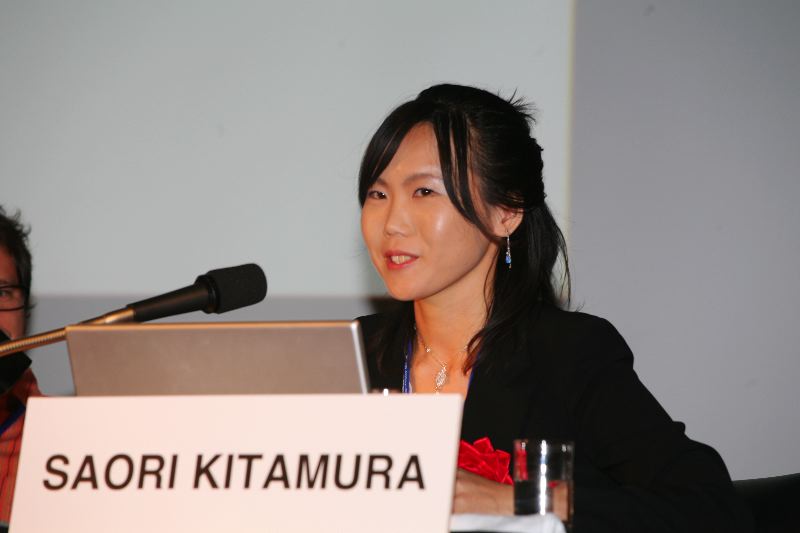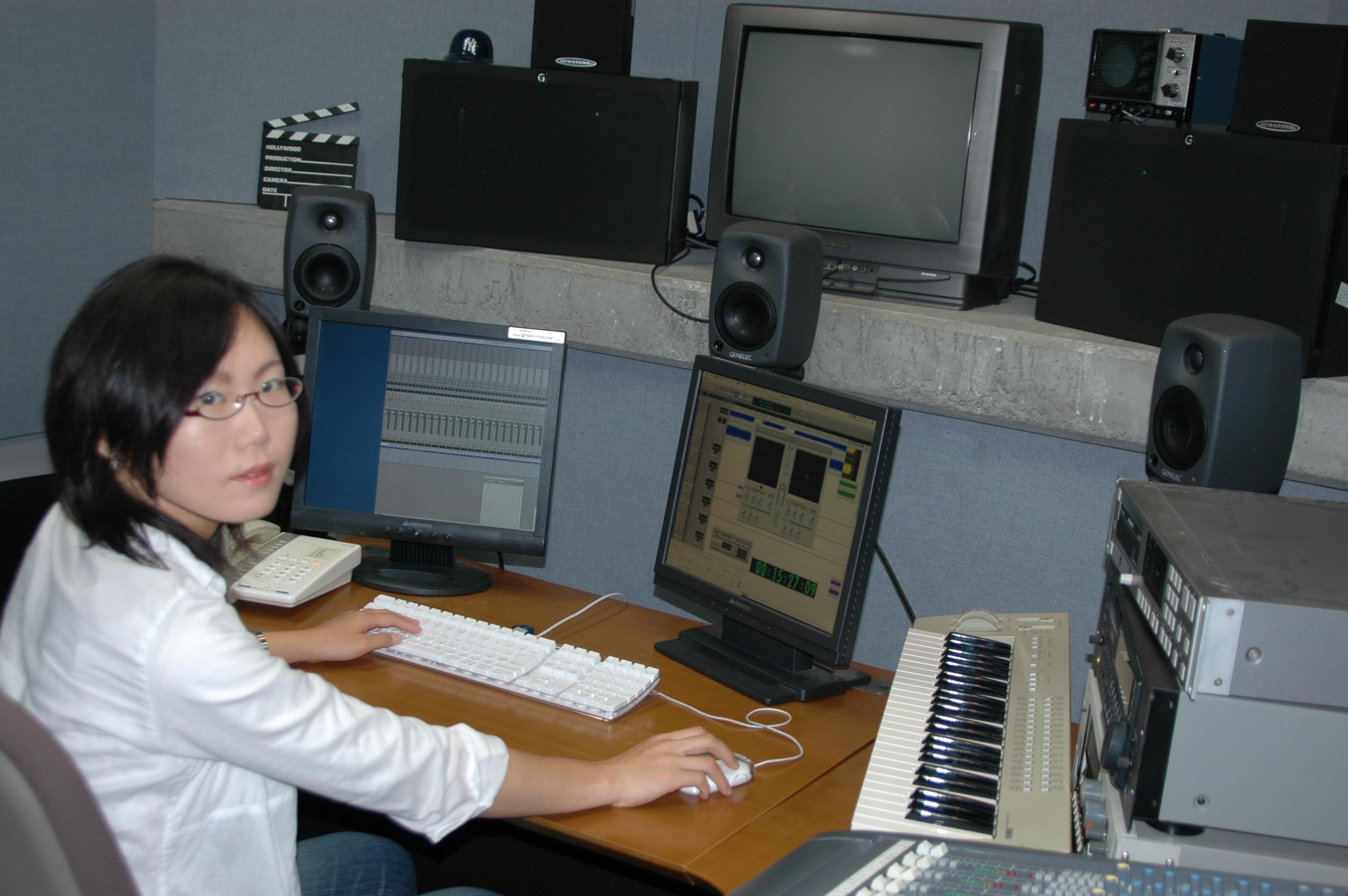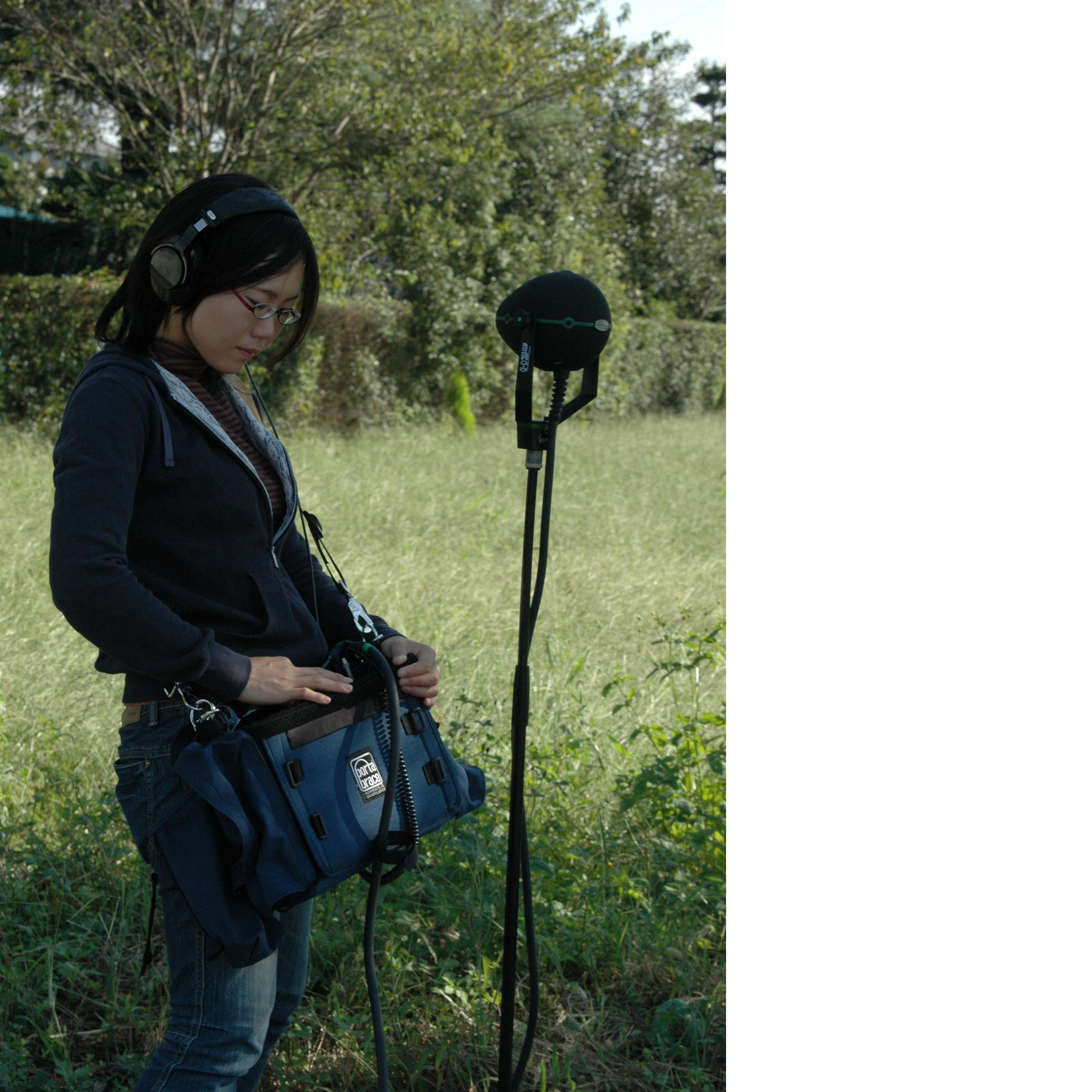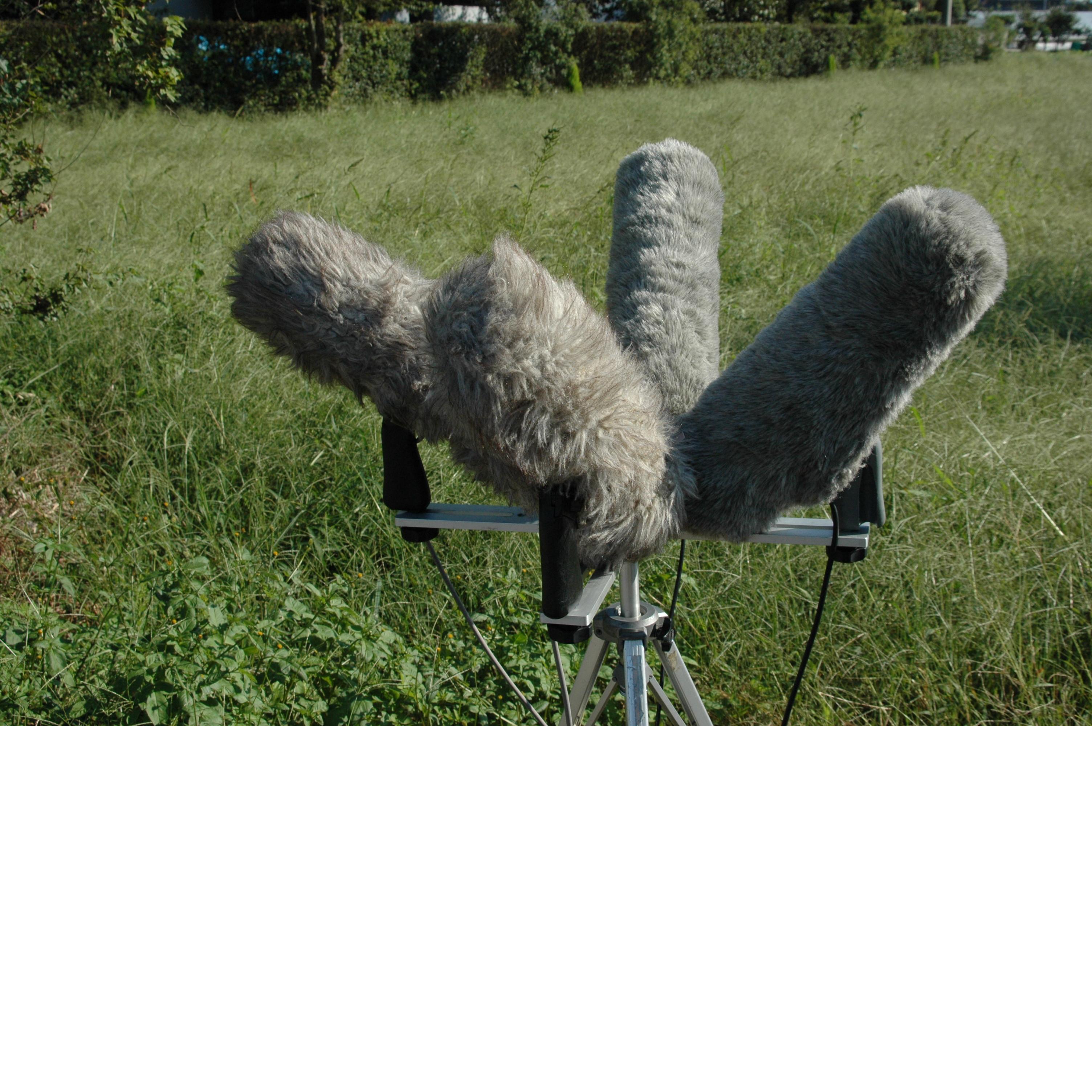[Inter BEE Forum 2007] Audio Symposium Report 3
2008.3.17 UP

4 Consideration of the role of surround sound in television commercials
Saori Kitamura, 1991 Studio
Due to a lack of background, there were difficulties recruiting panelists for this occasion. Then, upon consulting Mr. Nagata of the 1991 sound company, which has dealt with surround sound in the years since the Dolby surround age, it was suggested we select the panelists from his monthly commercial surround sound study group, enabling speedy convening of key members, including the young Kitamura, who is in her third year as a sound designer. Following is the outline of her address:
A television commercial is advertising designed to sell a product. In other words, it is a type of notice that should impress the audience, be memorable, and appeal to the audience's desire to buy the product. Needless to say fulfilling these criteria is always the main aim of commercial producers, who use their ideas and techniques to highlight the product's features and colors, and likewise the same creative demands are placed upon the sound designer.
Elements that comprise the structure of commercial audio
Narration = NA
Music = M
Sound Effects = SE
Synchronous Recording = SYNC
<Elements of commercial audio>
The best methods for expressing a product in the most impressive way vary with the product's features and colors. Opinions abound, however, I have attempted to sort the primary expressive nature of commercials in terms of genre in an audio context.
"Proven type": Clearly proven product characteristics! Simple sound design, intelligible and direct information.
"Image type": Product advertised using well-known or image music. Appeals to audience sensitivity as an impressive expression of image and sound.
"Documentary type": Uses the power of interview style live voice or ambient location sound to create product appeal with realistic impact.
"Special image type": Precision impact sound design. Employs exquisite multiplex digital processing such as CG.
"Commercial song type": Catchy musical melody and lyrics identifiable with brand name and image, causing the listener to hum the tune involuntarily.
<Commercial audio elements>
Current State of Commercials
Currently there are about 4500 commercials on rotation for the 5 stations in the Kanto region, being broadcast roughly 126,000 times every month (as of August 2007). In spite of this impressive figure, there are almost no commercials aired using surround sound. Stereo television broadcasting began in 1978, and at the same time audio for commercials began to move from monaural to stereo sound. However it took a few years for the changeover to complete, with stereo popularity becoming truly recognizable in the years 1983-84. Likewise with the introduction of digital broadcasting, one would expect it to take a number of years to move away from stereo to standardized surround sound broadcasting. Right now we are in this transitional period, and we believe we have the 4 years to 2011 to prepare for surround sound. Since the amount of information that can be expressed has increased with the times, we now have a situation where the information that has to be included in commercials exceeds the expressive capacities of the restrictive and short time allowed. The information is 'packed in like sardines in a can.' Imagine a lunch box into which all the sandwiches are stuffed in so tight that you realize there is no room left even for an ant to enter. It seems that the technique of squeezing the all the information into a few short seconds with liberal use of effects and so on has already been taken to its limit. Due to these limitations of current day stereo production, there has emerged a kind of homogeny among most productions; regardless of production methods are utilized. So, it seems we have reached the limitations of the capabilities of stereo expression.
The merits of surround sound for commercials
Today, media just keeps on diversifying. We can now watch movies over the internet with ease. In this environment, the survival and differentiation of the television commercial is in question.
The big difference when comparing stereo sound and surround sound is analogous to the difference between a flat surface and 3 dimensional space. A 5.1 surround sound system consists of a total of 6 speakers - front left, front right, center, left surround, right surround and a low frequency subwoofer. The attraction of the 5.1 system is that it creates a spatial wrapping sensation for the listener - the sense of actually 'being there' - coupled with the excitement provided by the separate low frequency subwoofer channel. These installations are not well understood or common in the average household, although the appeal of surround sound commercials far exceeds that of stereo. With a wider variety of available sound combinations and balancing possibilities, the spatially expressive power of the 5.1 surround sound 6 speaker system enables the sound designer to intensify sonic impact, or conversely create even more enjoyable sounds in a smart and efficient way. Surround sound gives more. More power to realize the director's goals, more impact for the audience, more scope for the sound designer. These are the benefits and attractions of surround sound commercials.
Examples of 1991 research projects
At 1991, we have been researching the best ways to bring out audio expressiveness, especially impact and presence in surround sound commercials. We have actually created some simulated surround sound commercials, using commercials originally produced in stereo that were not intended for surround sound. I would like to present 2 of these to illustrate our approach.
(1) Theme = Impact; Epson 'Tsuyo-ink (Strong Ink), the Hero Edition' (60 seconds)
Focuses on the key ideas of 'strength,' 'speed,' and 'originality,' and the sound design techniques that best express a 'stronger than strong' feeling in the surround sound context.
1. Plan
#Theme => 'Strength'...Fade resistant ink components that are firmly absorbed into the paper. #Accent shot => Strong inkman enters and lands resolutely on the paper.
2. Sound design
- Expressing power
- Landing on the paper
The moment strong ink man with his great absorptive powers lands on the paper, excitement is added via the subwoofer, previously absent in the stereo mix. This creates a surge through the air delivering a powerful sensation felt through the entire body, emphasizing the moment of landing.
- Lightening
The ink is strong and high definition. To further emphasize this feature, sound is layered up against individual lightening flashes. Whereas the lightening flashes were positioned only in the front in the stereo mix, they are positioned in the rear of the surround sound system also, giving the sensation of solidity highlighting the characteristics of presence, high definition and power, due to the spatial effect in which the lighting seems to be everywhere even though not actually all seen on the video.
- Power ink man zoom up and body wrapped in mantle
Shot zooms in on one person wrapped in a mantle following a line from front to rear running through a crowd of ink men. In the stereo mix, this movement from front to rear cannot be expressed very well, but by using the rear speakers in the surround sound set up, sounds fly out give a realistic sensation of movement, instead sound confined to the center of the screen as in the stereo mix. This way the zoom up on the mantle wrapped body more effectively emphasizes the idea of the strength and protection.
- Music
Repeatedly feeding back the '200!' voice from the rear to front in a clockwise direction gives the illusion of hearing the voice from behind, creating a wonderful effect impossible to achieve with stereo. This makes the '200!' voice extremely memorable. The stereo base material for this project has been expanded for surround using plug ins. Music mixing in surround sound would also be more desirable for surround sound commercials.
#In summary
In all areas of tone quality and positioning, it takes more detailed and precise work to comprehensibly assemble the sounds than stereo mixing, but the energy expressed is way above that delivered by the conventional stereo set up. The audience gets to experience the excitement of sounds flying out of the screen, the surprise of hearing voices from behind, and feel the impact through the body. This gets the message across much more directly than conventional stereo sound.
(2) Theme = Presence; '06 Formula Nippon Final - The New Fastest Tradition' (2006, 30 seconds)
This commercial aims to reinvigorate the motor sports fan's interest in the actual bodily excitement of being at a race track as a spectator. This is achieved by recreating that 'being there' feeling for the audience.
1. Plan
#Theme => Being at the race track = excitement #Emphasis shots => top shot, title, last shot (Racing cars in a cluster after the race start)
2. Sound design
Overemphasis of racetrack sounds could ruin the desired effect so music is featured for greater excitement in certain sections.
- Expressing the feeling of actually being at a race track
- A passage which captures the theme of being at the race track = excitement (top shot).
It is notable that the impact of the first shot can attract, or hook the audience in a commercial. By clearly positioning the presence in the center speaker, we were able to recreate the excitement of a high speed racing car whizzing past at 300km/h which you can actually feel in the body.
- Scene with 3 cars passing
A scene with the cars coming from the left rear, around a corner heading just shy of the left front. Actually the audio should be matched with the positioning in the video, but to really express the actual feeling of being at the race track, as an experiment we tried positioning the movement in the rear, in an attempt to create something difficult to express visually. To prevent the race cars passing one by one from becoming clustered, we moved the positioning slightly. The effect is that of actually being there when the cars come around the corner.
- Pitstop
To relay the feeling of racing cars from other teams whizzing past against the background of the one team's mechanics skillfully working in the pit stop, we positioned the pit stop audio in the front, while adding audio of unseen high speed race cars in the rear. This creates the live feeling of the race track experience by emulating the sense of immediacy and noisiness of the race track and pit stop.
- Last Shot
Although the video focuses on the leading cars as they move away from the pack, to further enhance the excited atmosphere right after the start we included crowd cheering noise in the rear. The sound is designed to give the listener the impression of actually being a spectator at the race track enjoying the climactic experience of the race start and the general enthusiasm and spirit of the location.
- Music
The stereo base material for this project has been expanded for surround using plug ins. Music mixing in surround sound would also be more desirable for surround sound commercials.
#In Summary
The rear audio provided by the 5.1 surround system captures the atmosphere of the racing circuit in a much more realistic way compared with stereo sound. Excitement is increased actually hearing the racing cars move from front to rear. The point here was to align the Doppler effect with the moving sound. We put reverb on the passing sounds in the title shot, and by using sound flying to the rear as reinforcement achieved a good balance for a commercial. For the start scene in the last shot, cheering was added in production to increase excitement, but since the starting sounds and the cheers have similar characteristics, positioning them to close in the front and back made them difficult to tell apart. So firstly, the racecars in the front are featured, and gradually the rear crowd cheering is faded in. This kind of scabbard timing of sounds enables the excitement and live sensation of the racing circuit to be more effectively communicated since the racing car and crowd noise become more distinguishable. The timing of sounds in the surround environment is an important sound design consideration, as well as careful analysis of the source material.
<PHOTO_2: Surround sound design>
<PHOTO_3: Recording with the HOLOPHONE H3-D>
<PHOTO_4: Recording surround sound in the field with 4 microphones>
Regarding the monitor levels, since commercials are broadcast to household televisions using radio waves, the final format of the product should be considered when setting monitor levels for sound design. Generally monitors are set to 85dB, but for these works the monitor level has been measured to be about 70 dB. The real attraction of surround sound is the experience of width, movement and spatial presence, even though there are more speakers and thus potentially more available audio power. So rather than using loudness to provide impact, sound design for surround sound commercials should be produced using the unique charm of the spatial dimension available.
A new discovery
1. Consider surround sound at the planning stage.
2. Enjoy the expanded expressive capability.
Basically the sense of actually 'being there' delivered by surround sound should be an enjoyable experience, and surely the sound designer's sense of creativity will also be further stimulated while exploring the possibilities that surround sound provides. The designer's enjoyment of 'spatial production' is the first step toward producing high quality commercials.
Moreover, product quality is further increased since the surround sound allows more scope to include audio not directly related to the video shots, giving more flow to the story and actually express more in the short time allowed for the commercial.
For instance, to move from one shot to the next the sound for the following shot can be introduced a little in advance of the actual shot, which give a sense of anticipation. This gives a more immediate understanding even for a first time viewing.
<???>
Particularly if the story goes well, superior quality and out-of-the-ordinary surround sound composition focusing on base noises can be more dramatically realized.
3. Narration on center speaker
In the simulation we used L, R divergence to position the narration in the center. Since the front speaker configuration is increased from 2 to 3 when the center speaker is included, narration and effects can be more efficiently positioned by making good use of the center speaker. Even if rear positioning is not required, just the addition of the center speaker audio takes the expressive power of the commercial to a higher level.
Aiming for quality commercials
Due to the increasing diversity of advertising media in the current era such as banner advertising, the effectiveness of television commercials is coming into question. For the foreseeable future, we have available 5.1 surround sound with digital broadcasting of digital high vision. To distinguish television commercials from other forms of media, the quality of commercials must be raised from the current conventions in order to compete for audience attention. With increased the scope available with surround sound, 'spatially produced' television commercials will have a fresh, new appeal for both sound designers and audiences. Ideally, the 5.1 surround system should become the standard for television commercials, but depending on concepts, would not be necessary for all commercials.
In a world of increasing media divergence where the television commercial business is always pursuing the new, the 5.1 surround system with its wider scope of audio expressiveness should show a strong competitive edge as yet unseen in the advertising world.
Finally I would like to talk bout the results of surveys taken at showings of our 1991 demos in Tokyo, Osaka and Nagoya. There were about 100 participants in the survey. The results show that people here in Japan feel the great potential for surround sound commercials. Ignoring results from people who didn't know about surround sound, it is clear that an effort is needed to build comprehensive infrastructure in the television advertising business.
READY to GO!!!
In the past, surround sound production has been a highly time consuming job. However technological developments mean that surround sound has become more accessible in recent times. Currently about 90 of the MA studios in Tokyo support surround sound. Industry standard sound design software applications such as Protools and Nuedo also support surround sound. Surround sound recording equipment such as HOLOPHONE surround microphones and portable multitrack recorders are also becoming more available. The surround sound production environment expected for 2011 is becoming a reality.
I am not talking about the future, these things are happening right now.
These are the results of the survey taken in Tokyo, Osaka and Nagoya when we showed experimental demos of 5 existing stereo commercials reedited for surround sound. There were about 100 participants in the survey.
Where did you feel the surround sound in those 5 commercials?
Is there a future for this in television commercials?
What are the issues facing surround sound television commercial production?
Using the six speakers of the 5.1 surround sound system, let's aim to produce high quality television commercials with more realistic impact and presence.
READY TO GO !!!
Demo: Epson
Questions asked from the participants
Q-01 What feedback has come from clients and producers who have heard surround sound?
Q-02 Internationally, what percentage of television commercials will be in surround sound in 10 years from now?
Q-03 How do you mix down surround sound?
Q-04 What is being done to create sound effects libraries in surround sound?
Q-05 What are the precautionary points regarding movie commercials and television commercials?
Q-06 What are the expressive possibilities for surround sound in artistic contexts other than commercials?
In Conclusion
Having spent a long time considering the attractiveness for listeners of surround sound in main program production, I also began to consider the business aspects. The reason was that I wanted to take a broader view of audio in commercials was so that management would not say that surround sound is only for the engineer's personal gratification . Happily, I feel that there has been some impact on the participants here today, thanks to the extensive demonstration material and the enthusiasm of the 4 panelists. Rather than have more seminars and study groups in 2008, I hope that there are more and more people in the commercial production business here in Japan who are interested in taking actual steps towards the surround sound goal. (Finish)










